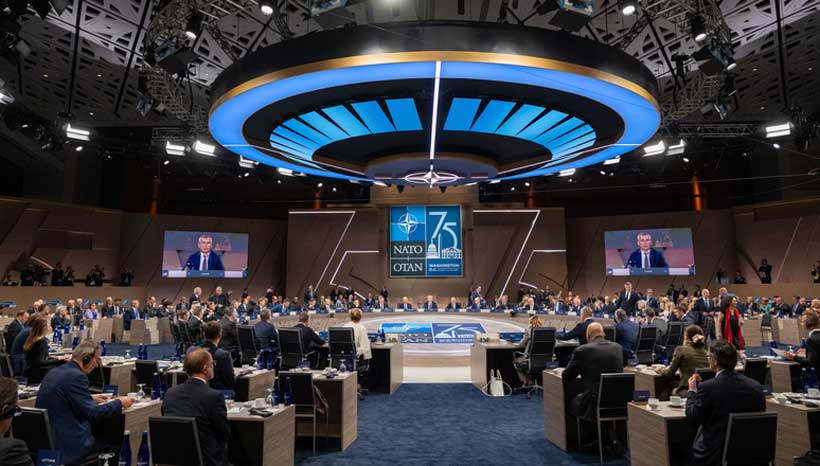Authors: Prajwal T. V and Dr. Karamala Areesh Kumar
April 2024 has marked the 75th anniversary of the formation of the North Atlantic Treaty Organisation (NATO) becoming the oldest military alliance to ever exist, standing as a cornerstone of international security, since 1949 from a 12-member alliance to counter the Soviet Union and providing security to the allies of the US, it has grown to a 32-member states alliance. Addressing the celebration of the 75th anniversary in Brussels on 4th April 2024, Jens Stoltenberg, the Secretary-General of NATO stated that the alliance has become “the most enduring, powerful and successful alliance in history,” with many others still hoping to join the alliance to be part of the collective defence enshrined in the Article 5 of the NATO Treaty that sets the precedence that an attack on one member being considered an attack on all, promoting deterrence and ensuring safety.
Understanding the historical significance of NATO and its recent expansion, particularly against the backdrop of geopolitical tensions and global risks such as the Russia-Ukraine and the Israel-Hamas conflicts, offers insight into its impact on peace and stability. Firstly, NATO’s historical context underscores its initial purpose i.e., to counter Soviet expansionism and maintain Western security and interest, especially in safeguarding democracies. Emerging from the ashes of World War II, NATO’s formation symbolised a collective commitment to deter aggression and uphold democratic values. However, the end of the Cold War saw the expansion of NATO membership to former Soviet bloc countries, a move that contributed to escalating tensions with Russia rather than fostering stability, now grown big enough to fit the ideals that America and Europe are stronger and safer together.
Over the years, the alliance played a pivotal role in stabilising the Balkans during the 1990s and has undertaken peacekeeping and counterterrorism operations in Afghanistan invoking Article 5 following the 9/11 terror attack, intervention in Libya to protect the civilians and then air policing in the Baltic regions providing security for the easternmost members. NATO’s rule of having members spend 2% of their GDP on defence has enhanced collective defence capabilities, facilitated the exchange of information, and provided a platform for cooperation between member states. Although NATO largely focuses on deterrence, efforts at conflict resolution and crisis management, its collective military capability and flexibility in deployments more than often dissuade potential aggressive enemy states; NATO’s collective resource ideally promotes stability in unstable regions.
However, over the recent past, NATO’s shadow support to Ukraine in its tensions with Russia and military deployments near Russia’s borders, ever since Russia’s invasion of Crimea have brought back criticism of Cold War mentality and accusations of mistrust that has completely deteriorated relations between NATO and the Russian Federation, more so after NATO granted membership to Sweden as its 32nd member just a year after granting membership to Finland. More than often, NATO’s interventionist policies are influenced by the United States in conflict-stricken regions such as Libya & Afghanistan, having failed to achieve their stated objectives has resulted in prolonged conflicts. On the other hand, extensive dependency on the military to resolve NATO members’ issues before diplomatic efforts additionally with many members not adhering to the 2% target of GDP spending has now led to the question of internal dissatisfaction witnessed during the Trump administration expressing the asymmetric distribution of NATO’s defence expenditure as well as facing new forms of threats including terrorism, inter-state conflict. NATO now faces more uncertainties than ever before but it has also grown stronger over the years despite internal strife, raising concerns over its efforts to maintain peace, stability and security. While serving as a collective security measure for member states, it has played the role of a hegemonic actor under the US’s leadership.
The Russia-Ukraine conflict and the Israel-Hamas conflict have both expressed a need for a strong Western Alliance at a time when NATO’s relevance was being questioned in a globalising multilateral and interdependent world order. This calls for NATO to expand its cooperation with non-member states, especially with Russia and China, to ensure a balance in the world through common security, dialogue and confidence-building measures. Provided that the 21st century has led to a stark rise in non-traditional security threats, over the domains of cyberspace, terrorism and the newer challenges posed by climate change, NATO needs to redefine what a security threat will mean in a digital era that is more environmentally unstable.
As Stoltenberg mentioned, the 75th anniversary is an opportunity for NATO to become serious and reflect not only on the alliances’ past achievements but also on contemporary conflicts that form an immediate threat to NATO in Europe and beyond. Leaving behind the Cold War mentality of antagonising Russia, there is an imminent need to adopt a more inclusive plan of action that is flexible enough to work with non-member states and actors to achieve cooperation to tackle non-traditional threats and continue to provide collective security.
